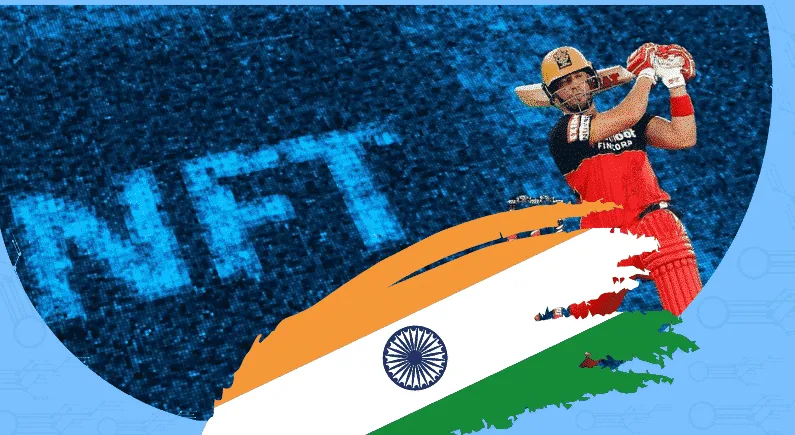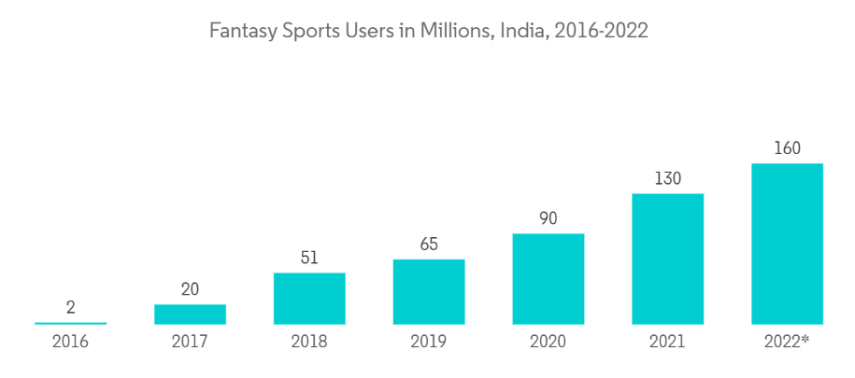Practitioners may have heard that in India, besides card and board real-money games, fantasy sports real-money games are also extremely popular locally.
According to Mordor Intelligence, by 2024, the number of fantasy sports players in India will reach 220 million.
As fantasy sports games become increasingly popular in India, more suppliers are starting to develop real-money games based on fantasy sports.
In the past, PASA has written many articles, basically clarifying the current situation of online gambling in India, and those interested can jump to read. Related article:《New Heights in iGaming Operations: Evaluating India's Real-Money Games! How to Enter the Indian Real-Money Gaming Market Creating $5 Billion in Revenue with Unique Details!》
Due to the regulatory openness of "skill-based" gambling games in India, card and board real-money games and fantasy sports real-money games can basically cover most of India's gambling players.
So in this article, PASA mainly explains what exactly are India's fantasy sports real-money games. How big is this market, and how can we, as newcomers, enter this niche track.
What are real-money games based on fantasy sports, and why are they popular in India
Fantasy sports are actually a type of online prediction-based simulation sports game, the most common gameplay being that players can form a fantasy team composed of real sports athletes in the game.
The performance of the players chosen by the player on the real field is all converted into scores, and the total scores of the players on the field are the player's score for that round, competing with other players by comparing scores.
Just looking at the definition of fantasy sports, it is hard to associate with the actual gameplay scenario, because the gameplay of fantasy sports is very similar to that of sports simulation games.
Next, PASA will help you understand the development of real-money games based on fantasy sports through a clear comparison of the gameplay of fantasy sports and sports simulation games.
For example, in the sports simulation mobile game "FIFA Soccer," players are given the opportunity to "be a player," controlling a team's players to compete against other teams, essentially testing the player's ability to simulate control of the game's players, with the score result being entirely based on the player's control skills.
Although sports simulation games are made based on real teams and players, the various game elements like season changes, transfers, player injuries, scores, etc., are disconnected from the real-world match information, and each player's "script" is definitely different.
So for players, the real role they play in these games is that of individual players. Of course, there are also sports simulation games like "Football Manager" where you play as a team manager.
On the contrary, in fantasy sports, players play as a "sports manager" of a real team, and all of their choices are based on real matches.
Specifically, for example, the web-based fantasy sports game Fantasy Premier League (FPL) based on the Premier League:
According to FPL rules, players can only choose 2 goalkeepers, 5 defenders, 5 midfielders, and 3 forwards.
A maximum of 3 players can be selected from the same club, and the total player budget cannot exceed the 10 billion pounds set in the game.
Each real player has their own price, which changes with the new season. Players who perform better and are more popular in real matches will be more expensive, but the 10 billion wage cap requires players to allocate each player reasonably.
After completing the selection of the 15-player roster, players need to select 11 starting players each week based on these players and designate one starting player as the captain, who will receive double points in this week's match.
Then, after the real Premier League matches end, each player's selected players will receive corresponding real player scores. For example, if a player chooses Haaland as the captain of their fantasy sports team, and Haaland scores a goal and gets the highest rating in this week's match, then correspondingly, the player will also be able to get double points.
When a week's cycle ends, the platform will base the player's score for the week on the total points of the starting players, and then compete and rank with other online players, finally distributing rewards based on the ranking.
Of course, depending on the match, the cycle time may also change, sometimes players may need to make changes every day.
So if you look at the core gameplay, the core gameplay of sports simulation games is online simulation;
while fantasy sports do not need to participate in the confrontation between teams, the core gameplay mainly depends on the player's prediction of players and matches, similar to sports betting.
Sports betting also allows players to predict wins, losses, goal differences, etc., based on their own judgments.
Although both fantasy sports and sports betting are based on predictions of real-world sports competition results, the essential difference also makes fantasy sports popular in the Indian market through gambling.
For sports betting, betting is relatively barrier-free, players can participate without understanding the sport, just based on luck.
But for fantasy sports, the element of luck is greatly reduced, players need to understand the players and matches to assemble their own fantasy team.
On one hand, continuously assessing the performance and value of players, avoiding "illusion" players when buying players, and needing to build a team within the wage cap.
The latter clearly raises the barrier in terms of skills, creating a significant gap between players who understand the sport and those who do not, thus allowing real-money games based on the fantasy sports mechanism to stay in India.
How big is the fantasy sports market in India, and how do we need to prepare to enter this market
Fantasy Premier League (FPL) once "warned" players:
"Fantasy sports are highly addictive, which can cause you to feel tense, lose free time, and have feelings of anger towards friends and colleagues."
The main reason why fantasy sports can be combined with online gambling is precisely because of its addictiveness, which is the same as various gambling projects;
Of course, its rapid development in India is highly related to local regulations, but the addictive nature of fantasy sports also makes its real-money games popular worldwide.
We'll talk more about this point in future articles, but here let's first talk about India.
According to Mordor Intelligence, the compound annual growth rate of the fantasy sports market in the Asia-Pacific region during the forecast period is 14.07%.
During the early stages of the COVID-19 pandemic, many live sports events were restricted, so as online audience participation increased, various platforms and operators of fantasy sports continued to expand, driving market growth.
After the pandemic, many sports events began to enter the process of online streaming, allowing the market to continue to grow rapidly.
In recent years, the launch of multiple sports leagues such as badminton, football, rugby, basketball, and cricket in the Asia-Pacific region has further promoted the secondary transformation of fantasy sports.
Also due to the pandemic, investments in digital and internet infrastructure have continued to increase, and technological advancements as well as the proliferation of smartphones and the internet have accelerated the development of the Asia-Pacific region.
During this period, the increase in smartphone usage has also brought a continuous stream of player users to fantasy sports.
Take the following chart from Mordor Intelligence as an example, the number of 5G smartphone users exploded rapidly after 2019, reaching over 1.3 billion 5G smartphone users in just 4 years.
The legality of fantasy sports in India has encouraged more user participation, and India also harbors the world's largest user base.
According to data from the European Statistical Office and the United Nations, as of February 2023, China had the highest number of mobile connections at 1.63 billion, followed by India at 1.1 billion.
As of last February, Australia had only 31.89 million mobile connections. However, Australia is one of the countries with the highest smartphone penetration rates, expected to reach 80.1% by 2025.
It is evident that the base of mobile users in India allows its fantasy sports market to expand unprecedentedly.
According to a discussion draft by India's NITI Aayog, fantasy sports are expected to attract nearly 100 billion rupees ($1.224 billion) in foreign direct investment in the coming years, creating over 5,000 direct jobs and 7,000 indirect jobs in the short to medium term.
In 2022, the number of users participating in fantasy sports in India reached 160 million,
and according to an annualized user growth rate of 23%, the number of players participating in fantasy sports games will exceed 220 million by 2024.
Therefore, India's fantasy sports market is fully comparable to card and board games, and card and board real-money games are expected to grow to a market size of $5 billion in the future.
And for designing real-money games for fantasy sports in India, its card and board real-money games are worth learning from.
We have said in the past that Rummy is the game most favored by Indian users, so designing games based on sports that Indian users love is the key to the project.
In the article "400 Million Viewers + Billion Revenue, The Breakthrough for Indian Sports Betting Lies in Cricket," it is mentioned that India has the largest cricket fan base, and cricket matches attract a large amount of betting from Indians.
In the past, India's offline sports betting was strictly regulated.
However, as fantasy sports betting provides a more transparent platform and offers various options for betting on different sports events, many Indian cricket users have started to switch to real-money games based on fantasy sports.
An organization closely cooperating with the Indian Super League (ISL) called ICS estimates that the scale of India's illegal betting industry is 110 billion pounds (about $145 billion), with an average of 80% driven by cricket.
If these bets can be effectively transferred to cricket real-money games, this market is believed to be sufficient to support most entrants to achieve wealth!
Now that we have a clear understanding of India's fantasy sports market and also know the direction to develop fantasy sports real-money games,
Next, PASA will give you two examples of the development of real-money games based on fantasy sports, to further explore the details of these real-money games.
For example, a cricket real-money game based on NFT released by Cricket Stars, the main selling point of this game is that it is a multiplayer game connected to esports events and championships all based on NFT.
Its used Tezos technology is a public, open-source blockchain, whose decentralized protocol relies on low-energy and energy-saving consensus.
Unlike the common "pay and reward" model, the feature of using NFT for delivery will attract more players to try it out. Players will be able to collect and trade exclusive cricket-themed NFTs through playing cricket games.
Additionally, Gamepind also launched a cricket fantasy sports product, which will integrate game and sports channel content into the Gamepind platform, which is currently professionally laid out in various segments of India's online gaming market.
Integrating sports information content with games is particularly effective for users focused on fantasy sports gameplay, similar to the "Rummy" real-money game, many Indian players do not play related games for gambling, but more out of a love for this type of game, and gradually join these real-money games.
Therefore, a game platform deeply tied to cricket content can attract more in-depth cricket enthusiasts and players. This is very similar to the fantasy sports game Fantasy Premier League (FPL).
Conclusion
Having a general understanding of India's fantasy sports real-money games and the enthusiasm of Indian players for cricket, I believe everyone has some aspirations for such a huge market.
However, to break into this blue ocean market, it is not something that can be achieved overnight to make big money here, first we need to understand India's cricket users well enough and be able to develop more innovative real-money games.
Finally, combine effective game advertising. (See: "From 0 to 70 Million User Downloads: In-depth Analysis of 100 Indian Game Advertising Campaigns, Detailed Explanation of How to Seize the Advertising Opportunities in the Indian Market")
Of course, some industry players believe that the cricket track in India is already too popular, and the competitive pressure will be very high.
This is true, but there are still many more niche tracks in India, such as real-money games based on esports, and PASA will specifically write an article about this later, so stay tuned.
In short, India's real-money game market is very large, and fantasy sports, especially cricket sports, as one of its segments, is already enough to make everyone earn a lot of money, and those interested might as well join us at PASA.
We look forward to discussing more unique insights about India's fantasy sports with our readers and invite you to follow the global iGaming leader's outbound information platform PASA for more industry information on getting rich.
Welcome to subscribe to the official PASA channel: https://t.me/PASAIGHYJL

















